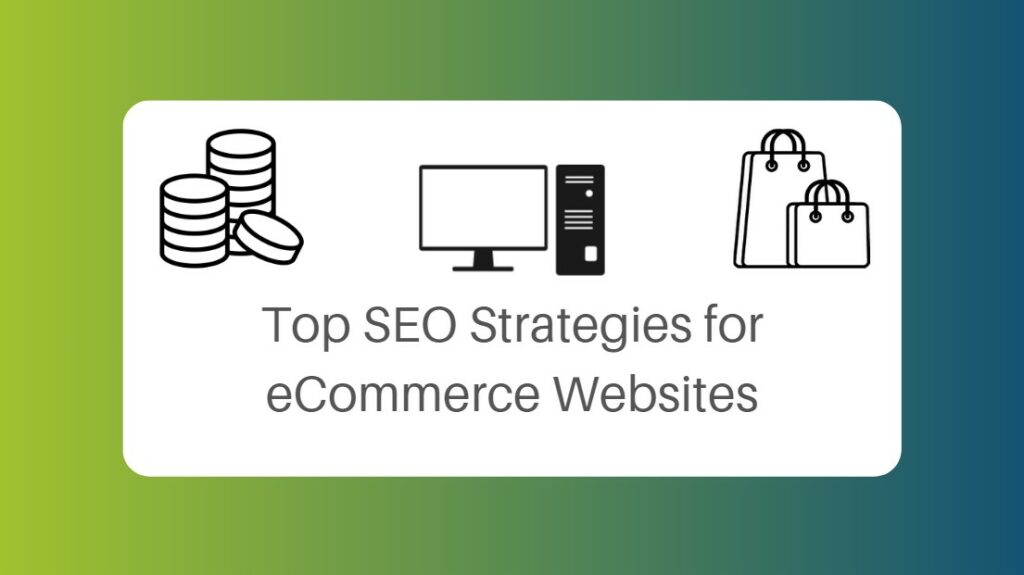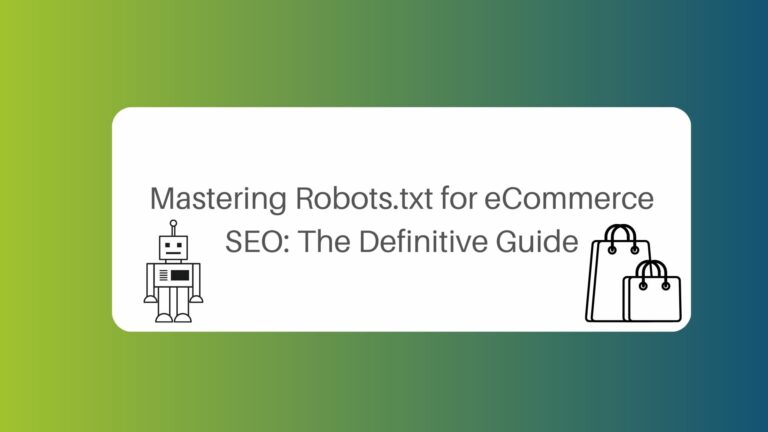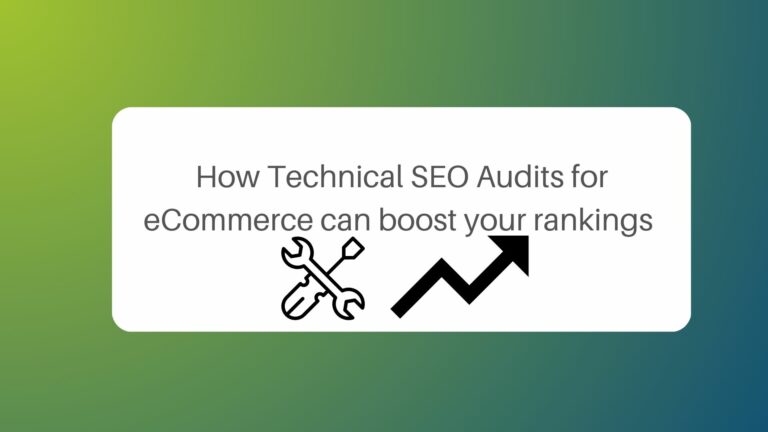In today’s digital age, having an eCommerce website is more important than ever before, if you’re looking to sell products. However, simply having a website is not enough; it needs to be optimised for search engines in order to drive traffic, generate leads, and increase sales.
This is where SEO strategies for eCommerce websites comes in. SEO, or search engine optimisation, is the process of improving your website’s visibility on search engines like Google, Bing, and Yahoo. 95% of search traffic goes to the first page of search results, so ranking top is a crucial aspect of online marketing, especially for eCommerce businesses.
In this blog post, we will be discussing five essential tips for improving the SEO strategy of your eCommerce website. We’ll cover everything from optimising your product pages and category pages to improving your site’s images and conducting a site audit. By implementing these tips, you’ll be able to improve your website’s rankings on search engines, drive more traffic, and ultimately increase sales.
So, without further ado, let’s dive into the world of SEO for eCommerce websites and discover how to optimise your site for success.
Tip 1: Product Pages
Optimising your eCommerce product pages for SEO is crucial if you want to drive traffic, generate leads, and increase sales. One key aspect of optimising your product pages is ensuring that they are visually appealing, informative, and user-friendly. Here are some tips and best practices that can help you achieve this:
- Use clear, high-quality images of your products, and optimise them with alt tags and descriptive file names.
- Clearly display your product prices to improve your eCommerce product page SEO.
- Use effective calls-to-action (CTAs) to guide visitors towards taking specific actions on your website.
- Include customer testimonials and reviews to build trust and credibility with potential customers.
- Use videos to showcase your products and improve the user experience on your product pages.
- Keep your product descriptions clear, concise, and engaging.
- Create a responsive, mobile-friendly eCommerce website to improve the user experience and accessibility.
For more information: 7 Tips to Improve Your eCommerce Product Page.
Tip 2: Product Images
Images are an integral part of any SEO strategies for eCommerce websites and can significantly impact your SEO. Optimising your images can improve your website’s loading speed, user experience, and search engine rankings.
Here are some key tips to optimise your eCommerce images for SEO:
- Compress large images to reduce the file size without compromising on quality.
- Use regular image sizes across your website to ensure consistency and improve the user experience.
- Avoid using too many colours and keep your images simple to enhance load times.
- Consider thumbnail sizes to ensure fast load times for category and search result pages.
- Use appropriate file formats such as JPEG or PNG to optimise image loading times.
- Use descriptive alt attributes to provide context to search engines about the image’s content.
- Consider using a CDN (Content Delivery Network) to improve website loading speed.
- Name your images correctly using relevant keywords to improve their discoverability by search engines.
For more information: How to Improve SEO for eCommerce Images.
Tip 3: Category Pages
Category pages are essential for eCommerce websites as they allow visitors to easily browse through products and find what they are looking for. Optimising your category pages can significantly impact your SEO and improve your website’s visibility in search engines.
- Here are some key tips to optimise your eCommerce category pages for SEO:
- Ensure your category page titles and URLs are descriptive and contain relevant keywords to improve their discoverability by search engines.
- Use descriptive product descriptions using relevant keywords to provide context and information about your products.
- Use clear headings and subheadings to structure your category pages and improve their readability.
- Build a sitemap for your category pages to help search engines crawl and index them.
- Use rich snippets such as product ratings, prices, and availability to provide more information to users in search engine results pages.
For more information: Improve your eCommerce Category Pages for SEO
Tip 4: Utilising Robots.txt for eCommerce
A robots.txt file is a simple text file that tells search engines which pages or files on your website they should and should not access. This can be useful for eCommerce websites as you may not want search engines to index certain pages or files, such as those containing sensitive information or duplicate content. Using a robots.txt file can also help improve your website’s crawl efficiency and overall SEO.
Here are some key tips for utilizing a robots.txt file for eCommerce SEO:
- Use a robots.txt file to block search engines from indexing pages that contain duplicate content or sensitive information, such as login pages or shopping carts.
- Ensure that your robots.txt file is properly formatted and located in the root directory of your website.
- Regularly review and update your robots.txt file to ensure that it is blocking search engines from accessing the appropriate pages and files.
- Use the robots.txt file in conjunction with other SEO best practices, such as canonical tags and redirects, to further optimize your website for search engines.
By utilizing a robots.txt file effectively, you can improve your website’s SEO and ensure that search engines are properly crawling and indexing your content. However, it’s important to be cautious when using a robots.txt file, as incorrectly blocking search engines from accessing important pages or files can have negative consequences for your SEO.
For more information: Mastering Robots.txt for eCommerce SEO: Definitive Guide
Tip 5: Technical SEO Audits for eCommerce sites.
Regularly conducting a site audit is crucial for improving your eCommerce site’s SEO. The reason for this is that having a high level of technical health on your site shows Search Engines that your site or page is of high value and therefor should rank high in SERPs.
In our previous blog on this topic, we discussed several key areas to focus on, including core web vitals and site speed, mobile responsiveness, site architecture, schema markup, indexing issues, and product page optimization.
In addition to these areas, it’s important to utilize the right tools to conduct a thorough site audit. Some of the tools we recommend include Screaming Frog, SEMrush, Ahrefs, Google Search Console, GTmetrix, and Moz Pro. These tools can help you identify technical issues, analyze your site’s performance, and uncover opportunities for improvement.
When conducting a site audit, it’s important to prioritize your findings and address the most critical issues first. This will ensure that you’re making the most impactful improvements to your site’s SEO. By regularly conducting site audits and utilizing the right tools, you can stay ahead of the competition and improve your eCommerce site’s visibility and performance in search results.
For more information: The Power of Technical SEO Audits for eCommerce
In this article, we have discussed 5 key tips to help improve your SEO Strategies for eCommerce websites. We started by discussing the importance of optimising product pages, followed by tips for improving images, and category pages.
Implementing these tips is essential for eCommerce businesses to improve their online presence and increase traffic to their websites. By optimising your product pages, images, and category pages, you can improve your search engine rankings and attract more potential customers.
We also discussed the importance of using a robots.txt file to improve eCommerce SEO and conducting regular site audits to identify and fix any issues that could affect your website’s search engine ranking.
We encourage readers to visit our previous blogs, which have been linked to each section, for more detailed information on each topic and to implement these tips on their own eCommerce websites. By doing so, you can improve your website’s SEO, increase traffic, and ultimately, boost your online sales.
So don’t wait any longer, take action today and start implementing these tips to improve your eCommerce website’s SEO!
Thanks for reading our collection of blogs on SEO for eCommerce websites. We hope they’ve given you some valuable insights into how to improve your website’s search engine rankings and drive more traffic and sales. If you have any questions or would like to learn more about our eCommerce Marketing Agency and more specifically SEO agency, please get in touch with us via the comments section or by phone or email.
[subscribe]












